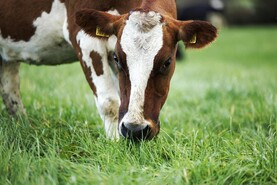Travelling the country, there are still a lot of clean-up bulls with dairy herds.
Cows bred this bank holiday weekend are due to calve mid-May, assuming a normal gestation.
Should the sire bring a longer gestation period, you are looking at a calf born in late May 2018.
Dairy farmers that still have clean-up bulls out are making a strategic decision to get more cows in calf and then look at options later in the year.
Two options
When these farmers scan in October they will have two main options, to hold the cows that have gone in calf and accept a spread out calving pattern or sell out of the parlour in milk.
Keeping the cows will suit some farms but those looking to have a compact calving and an easier to manage system will probably opt for option two, to sell.
Cows in milk have increased in value considerably in Northern Ireland in recent weeks and this is putting a pep in the step of milking cow sales as we head into the back end of the year for spring milk producers.
Remember, up north almost half the cows calve in September and October to produce winter milk and, with milk price increasing, many northern farmers often supplement herds with what they classify as cheap cows to produce more milk over winter months.
Many northern farmers supplement herds with cheap cows to produce more milk over winter months
Southern spring milk producers will soon be making decisions on autumn grass budgets and often the cows not in calf can be the release valve to lower stocking rates and allowing the farm build up grass covers.
Selling cows not in calf early can reduce stocking rate considerably and allow the milking herd stay out longer. These farmers need a plan to identify these cows and maiden heifers early in the autumn and make a call on options early, rather than waiting until December.
Rglebe Holsteins sell for up to 2,300gns in Dungannon
Greenfield update: peak milk cheque meets new costs
Bloat warning: three cows dead on midlands farm
Travelling the country, there are still a lot of clean-up bulls with dairy herds.
Cows bred this bank holiday weekend are due to calve mid-May, assuming a normal gestation.
Should the sire bring a longer gestation period, you are looking at a calf born in late May 2018.
Dairy farmers that still have clean-up bulls out are making a strategic decision to get more cows in calf and then look at options later in the year.
Two options
When these farmers scan in October they will have two main options, to hold the cows that have gone in calf and accept a spread out calving pattern or sell out of the parlour in milk.
Keeping the cows will suit some farms but those looking to have a compact calving and an easier to manage system will probably opt for option two, to sell.
Cows in milk have increased in value considerably in Northern Ireland in recent weeks and this is putting a pep in the step of milking cow sales as we head into the back end of the year for spring milk producers.
Remember, up north almost half the cows calve in September and October to produce winter milk and, with milk price increasing, many northern farmers often supplement herds with what they classify as cheap cows to produce more milk over winter months.
Many northern farmers supplement herds with cheap cows to produce more milk over winter months
Southern spring milk producers will soon be making decisions on autumn grass budgets and often the cows not in calf can be the release valve to lower stocking rates and allowing the farm build up grass covers.
Selling cows not in calf early can reduce stocking rate considerably and allow the milking herd stay out longer. These farmers need a plan to identify these cows and maiden heifers early in the autumn and make a call on options early, rather than waiting until December.
Rglebe Holsteins sell for up to 2,300gns in Dungannon
Greenfield update: peak milk cheque meets new costs
Bloat warning: three cows dead on midlands farm






 This is a subscriber-only article
This is a subscriber-only article









SHARING OPTIONS: